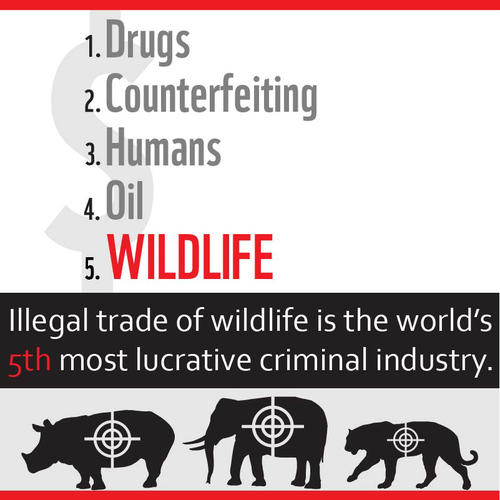When I mention the phrase ‘most lucrative crimes’, what
immediately comes into your mind? Is it the illegal sales of drugs? Or perhaps
is it the illicit trading of arms? Has it ever occurred to you that illegal
wildlife trafficking is actually one the largest and most profitable business,
at over US$20 billion? [1]
In South East Asia alone, Wildlife trade worth is an estimated of $8
to $10 billion annually,[2]
and majority of it is for unscientifically proven remedies for illnesses such
as aids and cancer. What is interesting is that even though the usage of animal
parts and their derivatives for their medicinal properties have been
scientifically refuted by the medical world, many people still continue to use
them. For instance, rhinoceros’ horns are used as cures for fevers, rheumatism and other disorders[3],
and the trafficking of their horns have led to a staggering decrease of
rhinoceros, of 40% from 70000 in 1970 to just slightly over 29000 in the wild
today.[4]

Quoting
from “<http://www.theguardian.com/world/2007/may/05/terrorism.animalwelfare>
“, ‘A
small rhino horn, the size of a bag of sugar, with good provenance (the beast's
tail and ears, presented to a prospective buyer) and in the right marketplace
(in Asia, Europe or North America), can fetch £20,000. Big cat pelts can go for
up to £10,000. Monkey brains, bear bile, musk, big cat carcasses, elephant
feet, tails, horns and teeth have considerable value. A shipment worth £2.8m
was recently intercepted by UK customs. Profits from the trade run from $15bn
to an incredible $25bn a year, according to estimates from the WWF (formerly
the World Wide Fund for Nature). The punishment for trading in these items is
generally a fine as low as £300 in India and £900 in Nepal.’
When the repercussions of getting caught trading the illegal items is so low, coupled with the ceaseless demand for animal parts, can the illegal trading of wildlife really be stopped?
To be discussed about further on:
With raised education level across the
globe, people are beginning to understand the true ‘effectiveness’ of their
local remedies. Yet, with that new found knowledge, illegal wildlife poaching
are still on the rise. What could be the cause of such atrocities, if not
for medicinal purposes then? Is there an underlying agenda for wildlife trafficking? What exactly is the main driver for these trafficking of animal parts? Also, where exactly does the revenue generated from the sales of animal parts goes to? Does illegal trafficking of wildlife only affect the animals, or will humans be implicated as well?
In my next post, I will be introducing
a special cure for all kinds of illness!
INSTANT RECOVERY FROM ANY ILLNESS
WITH A MAGICAL FINGERNAIL!!
[1]
Dener Giovanini; Taking Animal Trafficking Out of the Shadows
http://www.policyinnovations.org/ideas/policy_library/data/01377/_res/id=sa_File1/animal_trafficking.pdf
[2] http://muse.jhu.edu/journals/sais/summary/v026/26.1deeks.html
[3] http://www.savetherhino.org/rhino_info/threats_to_rhino/poaching_for_traditional_chinese_medicine
[4] http://www.savetherhino.org/rhino_info/rhino_population_figures

No comments:
Post a Comment